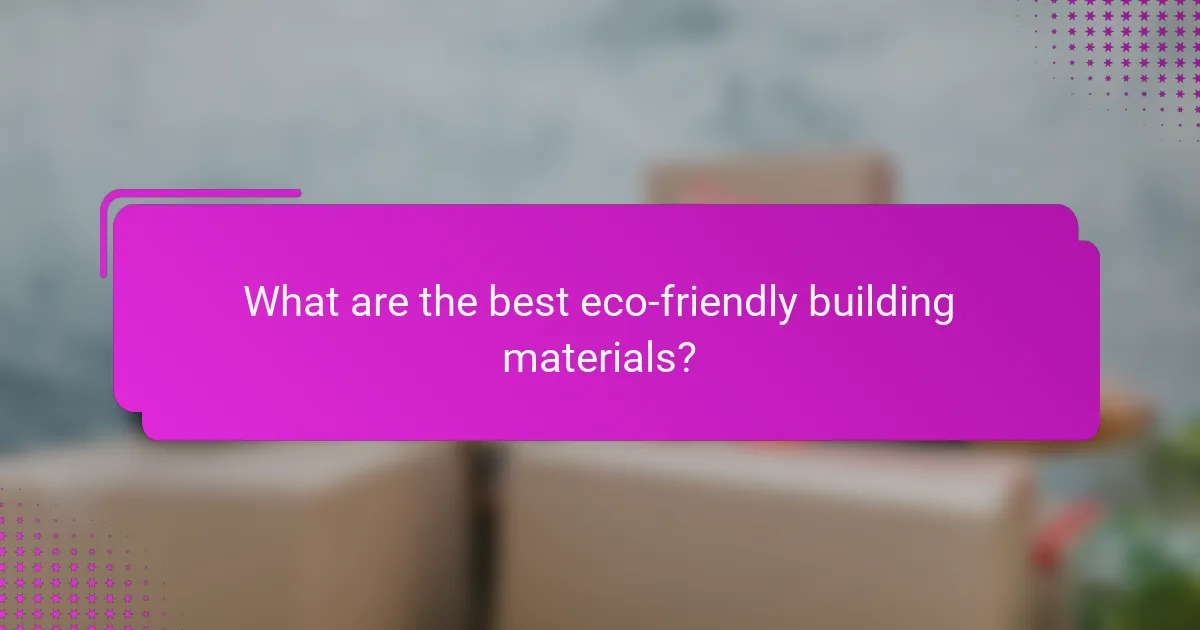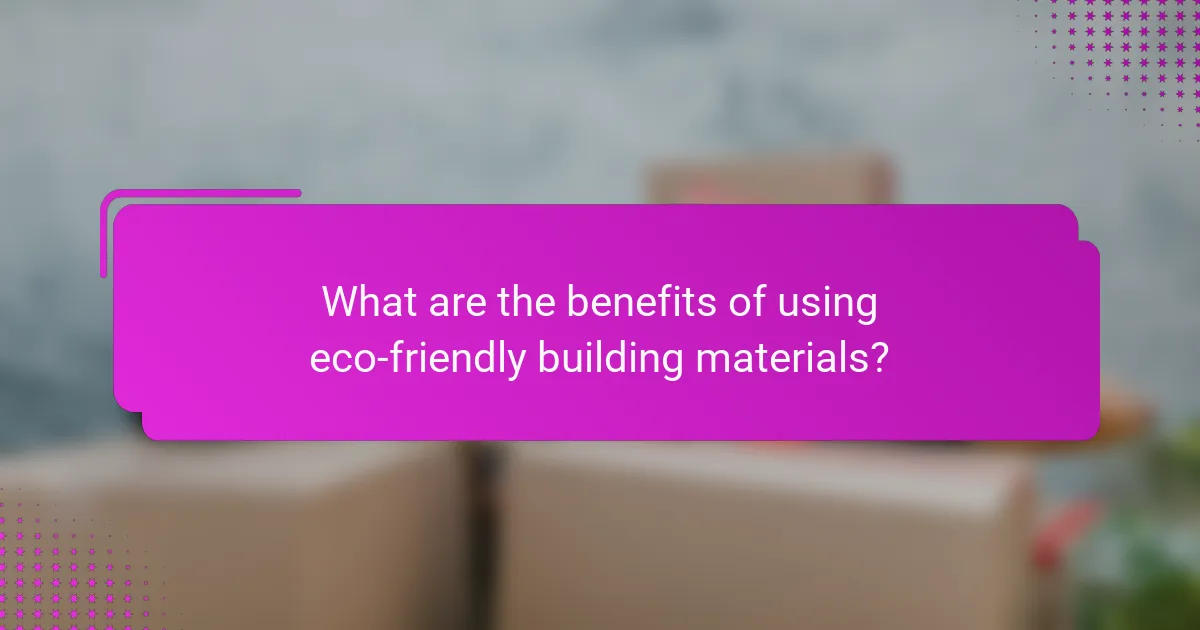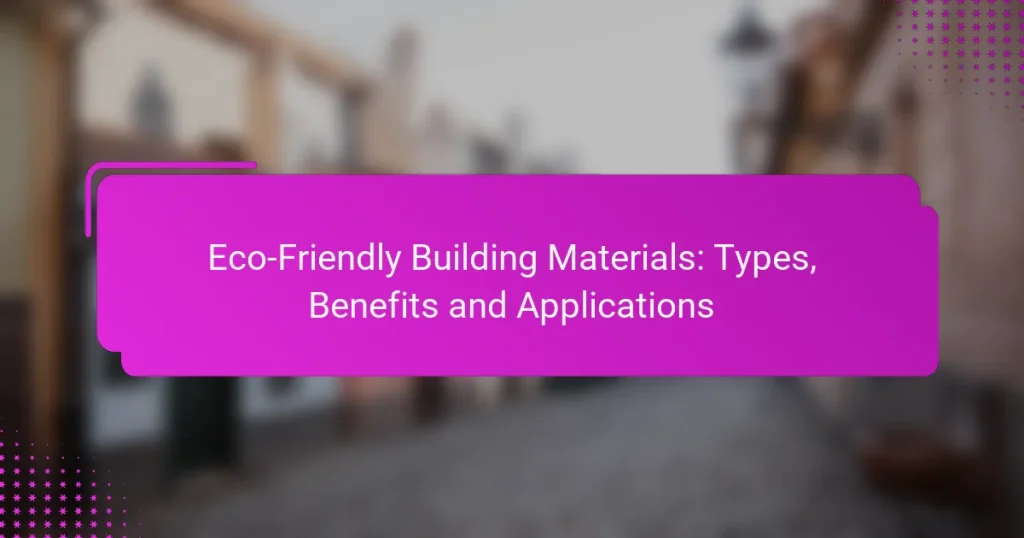Eco-friendly building materials are essential for sustainable construction, as they minimize environmental impact while ensuring durability and functionality. Options such as recycled steel, hempcrete, and reclaimed wood not only contribute to environmental sustainability but also offer health benefits and potential cost savings over time.

What are the best eco-friendly building materials?
The best eco-friendly building materials are those that minimize environmental impact while providing durability and functionality. Key options include recycled steel, hempcrete, reclaimed wood, straw bales, and bamboo, each offering unique benefits and applications in sustainable construction.
Recycled steel
Recycled steel is a robust and sustainable building material derived from scrap metal, significantly reducing the need for new steel production. It is known for its strength, longevity, and resistance to corrosion, making it ideal for structural applications.
When using recycled steel, consider sourcing from suppliers who adhere to environmental standards. This material can reduce construction waste and lower carbon emissions by up to 75% compared to traditional steel production.
Hempcrete
Hempcrete is a biocomposite made from hemp fibers and lime, offering excellent insulation properties and a low carbon footprint. It is lightweight and non-toxic, making it suitable for walls and insulation in eco-friendly buildings.
While hempcrete is not load-bearing, it works well in conjunction with other structural materials. Its ability to regulate humidity and temperature can enhance indoor air quality, making it a popular choice in sustainable architecture.
Reclaimed wood
Reclaimed wood is salvaged from old buildings, furniture, or other structures, providing a unique aesthetic and reducing deforestation. This material often comes with a rich history and character, adding value to new constructions.
When selecting reclaimed wood, ensure it is free from harmful chemicals and properly treated to prevent pests. It is ideal for flooring, beams, and decorative elements, contributing to a warm and inviting atmosphere.
Straw bales
Straw bales are an affordable and highly insulating building material made from agricultural byproducts. They are typically used in wall construction, providing excellent thermal performance and reducing energy costs.
Ensure proper moisture management to prevent mold and pests when using straw bales. This material is often used in natural building techniques and can be plastered or covered for added durability.
Bamboo
Bamboo is a fast-growing grass that serves as a strong and flexible building material, making it an eco-friendly alternative to traditional timber. Its rapid growth cycle allows for sustainable harvesting without depleting resources.
When using bamboo, consider its treatment to enhance durability and resistance to pests. It is suitable for various applications, including flooring, scaffolding, and furniture, making it a versatile choice in green building projects.

What are the benefits of using eco-friendly building materials?
Using eco-friendly building materials offers numerous advantages, including environmental sustainability, health benefits, and potential cost savings. These materials help reduce the negative impact of construction on the planet while enhancing the well-being of occupants.
Reduced carbon footprint
Eco-friendly building materials typically have a lower carbon footprint compared to traditional options. Materials such as bamboo, reclaimed wood, and recycled steel require less energy to produce and transport, which significantly cuts down greenhouse gas emissions. Choosing local materials can further minimize transportation impacts.
To maximize the reduction in carbon footprint, consider materials that are certified by recognized standards, such as the Forest Stewardship Council (FSC) for wood products. This ensures that the materials are sourced sustainably and responsibly.
Improved indoor air quality
Many eco-friendly building materials are free from harmful chemicals and volatile organic compounds (VOCs), which can negatively affect indoor air quality. For instance, natural paints, low-VOC adhesives, and non-toxic insulation materials contribute to a healthier living environment.
Using materials that promote better air quality can lead to reduced respiratory issues and allergies among occupants. It’s advisable to check for certifications like Green Seal or GREENGUARD when selecting products to ensure they meet stringent air quality standards.
Energy efficiency
Eco-friendly building materials can enhance energy efficiency in homes and commercial buildings. Insulation made from recycled materials or natural fibers can significantly reduce heating and cooling costs by maintaining stable indoor temperatures.
Incorporating energy-efficient windows and roofing materials can further minimize energy consumption. For example, reflective roofing can reduce heat absorption, leading to lower air conditioning needs during hot months, which can save on energy bills over time.
Cost savings in the long term
While eco-friendly building materials may have a higher upfront cost, they often lead to significant long-term savings. Reduced energy bills, lower maintenance costs, and potential tax incentives for green building practices can offset initial investments.
Homeowners and builders should consider the lifecycle costs of materials, including durability and maintenance requirements. Investing in high-quality, sustainable materials can result in fewer replacements and repairs, ultimately saving money over the lifespan of the building.

How do eco-friendly materials compare to traditional materials?
Eco-friendly materials often outperform traditional materials in sustainability, health, and energy efficiency. While traditional materials may be cheaper upfront, eco-friendly options provide long-term benefits that can outweigh initial costs.
Durability and lifespan
Eco-friendly materials like bamboo, reclaimed wood, and recycled steel are known for their impressive durability and lifespan. For instance, bamboo can last up to 25 years, while reclaimed wood can endure for decades if properly maintained. In contrast, some traditional materials may require more frequent replacement, leading to higher long-term costs.
When selecting materials, consider the specific environmental conditions they will face. For example, materials used in humid climates should resist moisture and decay, while those in arid areas should withstand extreme temperatures.
Environmental impact
Eco-friendly materials typically have a lower environmental impact than traditional options. They are often sourced sustainably, reducing deforestation and habitat destruction. Additionally, many eco-friendly materials are recyclable or biodegradable, minimizing waste in landfills.
For example, using recycled concrete can significantly reduce the carbon footprint associated with new concrete production. Understanding the life cycle of materials—from extraction to disposal—can help in making more environmentally conscious choices.
Cost analysis
While eco-friendly materials may have a higher initial cost, they often lead to savings over time through energy efficiency and reduced maintenance. For example, energy-efficient insulation can lower heating and cooling costs by 20-30%. In contrast, traditional materials may require more frequent repairs or replacements, increasing overall expenses.
When budgeting for a project, consider not only the upfront costs but also the long-term savings associated with eco-friendly materials. This holistic approach can lead to more sustainable financial decisions in construction and renovation projects.

What are the applications of eco-friendly building materials in construction?
Eco-friendly building materials are utilized in various construction applications, enhancing sustainability and reducing environmental impact. These materials can be found in residential buildings, commercial structures, and renovation projects, each serving specific purposes and benefits.
Residential buildings
In residential construction, eco-friendly materials such as bamboo, reclaimed wood, and recycled steel are increasingly popular. These materials not only reduce the carbon footprint but also improve energy efficiency, leading to lower utility bills for homeowners.
For instance, using insulated concrete forms (ICFs) can enhance thermal performance, while solar panels can be integrated into the design for renewable energy generation. Homeowners should consider local availability and building codes when selecting materials.
Commercial structures
Commercial buildings benefit from eco-friendly materials through improved sustainability ratings and reduced operational costs. Materials like green roofs, low-VOC paints, and energy-efficient glass can significantly enhance a building’s environmental performance.
Many businesses are now pursuing LEED certification, which encourages the use of sustainable materials. Companies should evaluate the long-term savings versus initial investment when choosing eco-friendly options for their projects.
Renovation projects
Renovation projects offer an excellent opportunity to incorporate eco-friendly materials, especially when retrofitting older buildings. Using recycled materials, such as reclaimed bricks or salvaged fixtures, can preserve the building’s character while promoting sustainability.
Homeowners and contractors should prioritize energy-efficient upgrades, such as installing high-performance insulation or energy-efficient windows, to maximize the benefits of renovations. It’s essential to assess the existing structure’s compatibility with new materials to ensure a successful integration.

What criteria should be considered when selecting eco-friendly building materials?
When selecting eco-friendly building materials, consider factors such as local availability, sustainability, energy efficiency, and health impacts. These criteria help ensure that the materials not only reduce environmental impact but also support local economies and promote healthier living spaces.
Local availability
Local availability of eco-friendly building materials is crucial for reducing transportation emissions and supporting regional economies. Materials sourced nearby often have a lower carbon footprint and can be more cost-effective due to reduced shipping expenses.
When evaluating local options, consider materials like reclaimed wood, locally produced bricks, or natural stone that are abundant in your area. Research suppliers and manufacturers within a reasonable radius to find sustainable choices that fit your project.
Additionally, check for any local regulations or incentives that promote the use of regional materials. Many municipalities offer tax breaks or grants for projects that utilize locally sourced eco-friendly materials, making them even more appealing.


